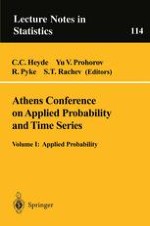1996 | OriginalPaper | Buchkapitel
Large deviations of the Wright-Fisher Process
verfasst von : F. Papangeloul
Erschienen in: Athens Conference on Applied Probability and Time Series Analysis
Verlag: Springer New York
Enthalten in: Professional Book Archive
Aktivieren Sie unsere intelligente Suche, um passende Fachinhalte oder Patente zu finden.
Wählen Sie Textabschnitte aus um mit Künstlicher Intelligenz passenden Patente zu finden. powered by
Markieren Sie Textabschnitte, um KI-gestützt weitere passende Inhalte zu finden. powered by
In the present paper we will be concerned with the Wright-Fisher process of mathematical genetics in one of its simplest forms: the univariate case with no selection and with either no mutation or only one-way mutation. Consider a large biological population consisting of a single species in which a particular gene appears in two possible forms (alleles) A and a, say. Assume that we are dealing with a one-sex population (as with some plants) and that we are in the haploid case (in which chromosomes occur singly). The Wright-Fisher process models the way in which the proportion of individuals carrying the A form of the gene changes from generation to generation, as the population reproduces itself ([1], [4]). To be specific, let us first consider the case where the proportion of the A allele changes only through the effect of random sampling, with no mutation or selection. If the population consists of N individuals i of whom are of type A and N–i of type a, then the state of the process is the proportion $$ y = \frac{i}{N} $$ To produce an offspring generation from this population of “genes” we sample N times with replacement from it, thus keeping the size of the population constant. The probability that the proportion of A-alleles will make a transition from state $$ y = \frac{i}{N} $$ in the “current” generation to state $$ \tilde y = \frac{j} {N} $$ say, in the following generation is then 1.1$$ P\left( {y,\tilde y} \right) = \left( {\begin{array}{*{20}{c}} N \\ j \end{array}} \right){y^j}{\left( {1 - y} \right)^{N - j}} $$
